How to Create a Social Media Content Calendar: Tips and Templates
A social media content calendar is like the Marie Kondo of your entire social media strategy. It sounds like a big commitment at first, but you can rest assured it’ll pay that time back in the future. (Not to mention preventing minor panic attacks.)
Whether it’s a simple grid with a few links, or a bespoke dashboard that can plan out dozens of feeds, your calendar can be as simple or complex as your brand needs it to be.
Read on and we’ll guide you through the steps necessary to make your own, and take a look at some real-world examples. We’ll also list our favorite social media content calendar apps. Oh, and we’ve built some free social media content calendar templates to get you started.
But first, let’s review the compelling reasons to invest in this tool to begin with.
Table of Contents
Why use a social media content calendar?
How to create a social media content calendar
Social media content calendar examples
Free editorial and social media calendar templates
Other social media content calendar apps and tools
Bonus: Download our free, customizable social media calendar template to easily plan and schedule all your content in advance.
Why use a social media content calendar?
1. Save time by being organized
Your social media marketing goals have a key point in common with many of the other goals in your day planner: they take effort and attention every single day. Not just when you’re feeling inspired (or at 11PM when everything else is taken care of).
Maintaining a social media calendar lets you plan ahead, batch your work, avoid multitasking, and note down all your creative brainwaves for later.
Basically it’s the best way to make sure you’ll never find yourself desperately scrolling through generic inspirational quotes hoping to find something to post ever again.
And even though you’ll be posting every day, maybe multiple times a day, that doesn’t mean you need to be babysitting your feeds constantly. Certain social media calendar tools allow you to schedule social media posts ahead of time, and, just as important, manage your engagement from one place.
2. Post consistently
Whether you’re trying to increase your Instagram likes, your YouTube subscribers, or you’ve implemented social media KPIs, the first tip from experts will always be “post consistently.” There’s just no shortcut around it.
Why?
Consistently showing up in your audience’s feed is the key to engaging them on social. Impressive engagement increases your organic reach via the platform’s algorithm, so your posts get shown to new eyes, and new people start following your brand. And making genuine connections with a growing audience is the one true path to lifting your conversions.
Populating your social media content calendar with posts ahead of time allows you to post consistently whether it’s a slow news week, or your biggest promotion of the year.
3. Make fewer typos, and also reduce the risk of big mistakes
Planning your posts ahead of time means that you can build failsafes into your workflow. Copy-editing the text, fact-checking information, or even vetting it with organizational stakeholders like the legal team or C-suite, are all a lot easier when you’re working days or weeks in advance.
A social media calendar—especially one with team member approvals built in—is the best way to prevent a low-key embarrassment like posting the same message across channels, or a high-key social media crisis.
4. Get more ambitious with your social strategies
The world’s biggest social media brands are often running multiple campaigns at once—long, medium and short-term, paid and organic. And that’s just the day-to-day posts.
Once you have your schedule nailed down, your glorious brain is freed up to tackle even bigger questions. Should you run an Instagram contest? Start looking for influencer partners? Maybe it’s time to get your brand on LinkedIn, or introduce a social media employee advocacy program.
Whether you’re managing a five-person content team or you’re posting your Story while mixing bleach for your 3pm client’s pastel ombre long-bob, getting your social game to the next level means getting organized.
5. Don’t miss out on relevant moments
Never forget about the Super Bowl again. (Or, you know, make sure you’re ignoring it on purpose.)
A social media calendar allows you to strategically observe worldwide global moments that are relevant to your brand’s audience.
Like, for instance, Star Wars day.
Chewbacca walnut.#MayThe4th pic.twitter.com/ca8BFrD7xr
— Present & Correct (@presentcorrect) May 4, 2019
Party words. Excellent.https://t.co/rNfbq3ZPAN
— Merriam-Webster (@MerriamWebster) December 31, 2019
Also, with your day-to-day schedule covered, if something topical comes up—like maybe Jennifer Aniston joins Instagram or an egg gets bigger than before—you have the creative and logistical bandwidth to engage with the moment in an on-brand way.
6. Make higher-quality content
Social media production values have skyrocketed since the early days, and the notion of a lone-wolf Millennial tweeting memes from their beanbag chair has gone the way of the jegging. (Ok, ok, except for whoever is behind Moonpie.)
Today, it’s not that unusual for a single social media post to have a whole team of creatives behind it: copywriters, designers, video editors, photographers. And asking your team of hard-working artistes to drop everything for an emergency Instagram Story is not going to win hearts or minds. (And it’s not even guaranteed to earn engagement, if it feels slipshod or pushy.)
A social media calendar helps you allocate your assets—both human and digital—effectively, so that your team has the breathing room to do their best work.
And a long-term vision means you’re pushing a consistent brand voice and content that supports your marketing goals.
7. Track what works, and improve it
What gets scheduled gets done, and what gets measured gets improved.
Your social media analytics have a lot of insights for you. A social media content calendar provides the opportunity to schedule your experiments towards improvement. Plan out your A/B tests until you find the right recipe for the type of content, format, post frequency, and best time of day to post for each social platform.
How to create a social media content calendar
There are 8 steps to creating an effective social media calendar:
- Audit your social networks and content
- Choose your social channels
- Decide what your calendar needs to track
- Make a content library for your assets
- Establish a workflow
- Start crafting your posts
- Invite your team to review, and use their feedback to improve
- Start publishing/scheduling
Pro Tip: If this is your first time making a calendar for social, you might want to crack open our guide to creating a social media marketing strategy first. Your calendar will be all the better for having clear goals to underpin it.
1. Audit your social networks and content
Developing a clear picture of your current social media efforts will let you identify areas for improvement and opportunities for new efforts. An audit is key to fine-tuning your strategy and maximizing your ROI.
Start with our social media audit template. This will result in precise, up-to-date data on:
- Impostor accounts and outdated profiles
- Account security and passwords
- Goals and KPIs for each branded account, by platform
- Your audience, their demographics and personas
- Who’s accountable for what work on your team
- Your most successful posts, campaigns and tactics
- Gaps, underwhelming results, and opportunities for improvement
- Key metrics for measuring future success on each platform
Budget some dedicated time to go through all of your social assets. Then rest assured that you’ll be tackling your refreshed social strategy with the best information. That is, the information that’s unique to your audience, accounts and brand.
2. Choose your social channels
It seems like every social media manager we know got the same Slack message last year. Some random higher-up going Hey there! [sunglasses emoji] Why aren’t we on TikTok?
(Pro Tip: Have an impartial third party drop your boss a link to 6 Things You Should Never Say to Your Social Media Manager.)
In the hustle and bustle of the daily grind, it takes concerted effort to find the time to stay on top of new developments. Like, should your brand care about Instagram Threads? And is your audience even on TikTok?
This is why you should take a minute to make sure you’re clear on each social media platform’s user demographics. And review best practices for business marketing strategies, too. Naturally, we here at Hootsuite have compiled the most complete guides possible:
- Instagram marketing strategy
- Facebook marketing strategy
- YouTube marketing strategy
- Twitter marketing strategy
- LinkedIn marketing strategy
- Pinterest marketing strategy
We’re not saying you have to go into freshman-year-organic-chemistry-exam mode and absorb it all at once. Just take some professional development reading breaks during that post-lunch lull, and you’ll be sparkling with new insights and ideas in no time.
3. Decide what data your social media content calendar needs to track
As you figure out what this beautiful beast is going to look like, (and where it’s going to live, a.k.a. a permanently-open Chrome tab between Gmail and Slack) you want to map out the information and functionality this tool is going to provide to you.
Maybe you’re starting fresh for, say, your side-hustle doing social for local indie rappers. In which case a simple spreadsheet might do.
But if you’re managing a seven-person team with a dozen different consumer-facing brands, you’re going to want something that can tell you who’s doing what, when it’s done, when it’s approved, and when it’s published—and then how successful it was.
(Spoiler: Sometimes a spreadsheet is not enough, which is why there’s a list of all our favourite tools at the end of this article.)
So we advise you to start with basic details:
- Platform
- Date
- Time (and time zone)
- Copy
- Visuals (e.g., photo, video, illustration, infographic, gif, etc.)
- Link to assets
- Link to published post
Also, add more advanced details that you might potentially find helpful. (You can always nix them later if they’re redundant.) Details like:
- Platform-specific format (eg., feed post, IGTV, Story, poll, live stream, ads, shoppable posts, etc.)
- The vertical or campaign it’s affiliated with (eg., product launch, event, contests, annual giving, general brand awareness, customer service, etc.)
- Geo-targeting (i.e., is it global, North American, etc.)
- Value (i.e., Is it a short-lived topical post or a big-budget evergreen showpiece that could be recycled or cannibalized for parts down the line?)
- Paid or organic? (If paid, then additional budget details might be helpful)
- Has it been approved?
- Has it been posted? (If so, do you want to include the link with its UTM?)
- Analytics and results (Generally at this level of complexity you probably rely on your analytics reports to contain and explain this information.)
4. Make a content library for your assets
Some people like to call these content repositories or media resource databases or digital asset banks.
Regardless of what you call it, your supply of visual content should not be living on your iPhone, or in a bunch of desktop folders marked “misc social.” (Ok, ok, at least don’t keep them there permanently.)
You can use Dropbox, Google Drive, your company’s internal network, or made-to-purpose database software. A social media content library has a few key features:
- It’s spacious enough for large files;
- It’s accessible from your phone as well as your computer (trust me on this one);
- It’s easily shareable with team members, but you can trust its privacy features;
- It provides links to individual files so that you can plunk them into your calendar (or perhaps it interfaces with your calendar natively).
The way you set up your content library is almost as important as your social media content calendar. The less searching around for assets that you have to do, the better.
For instance, Hootsuite’s content library feature is seamless within the calendar feature, so that you’re barely aware they’re two different tools. See how it works in the video below.
5. Establish a workflow
Ok, now that you’ve gathered all possible information, it’s time to start sketching in the bones of your daily, weekly and monthly social media cadence.
You’ll want to think about:
- How often you want to post to each channel;
- The best time to post to each channel (based on your analytics; or else check out our full breakdown here);
- What your content ratio will look like (an easy starting point is the rule of thirds, which is #8 on our list of social media best practices);
- Who needs to approve posts (e.g., your copy-editor, your legal team, your CEO) and how communication will work there;
- What the process is for brainstorming new content, not to mention assigning and creating it.
Pro Tip: Once you have a social media workflow outlined, consider documenting it in an easy-to-access place (say, a separate tab in your social media calendar spreadsheet). The more complex your team, the more helpful it is to break down definitions and processes so that you’re not answering texts from colleagues when you’re supposed to be chomping beignets in the French Quarter, or getting a root canal.
This example from social innovation NGO Digital Opportunity Trust shows how their communications team keeps a “guidelines” tab in their calendar, with helpful resources like branding and official visuals linked.
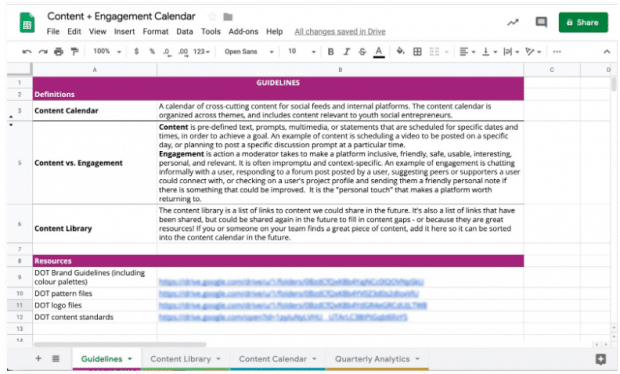 Source: Digital Opportunity Trust
Source: Digital Opportunity Trust
6. Start crafting your posts
At this point you’re probably raging with ideas, right? Take some time to go through that old “misc social” folder and start pulling together some discrete posts.
Bonus: Download our free, customizable social media calendar template to easily plan and schedule all your content in advance.
Get the template now!As you work, evaluate how your calendar feels. If it’s onerous and finicky, maybe you want to dial back some of the detail. Or maybe it’s not detailed enough and you need to add a few columns. (Or maybe it’s just… kinda ugly, in which case check out our beautiful free templates, in the next section.)
 Source: the author
Source: the author
On the other hand, if you’re feeling stumped for posts that go beyond next Tuesday, we have a social media content ideas cheat sheet right here.
7. Invite your team to review, and use their feedback to improve
Now that you’ve sculpted the foundations of your organizational empire, it’s time to reveal your work to the world, or at least to your colleagues.
You want your calendar to be moderately intuitive, so send an invite around to the people who’ll need to use it every day (or every day you’re on vacation).
Ask them to put it through its paces, and schedule a meeting for everyone to connect on findings. You’ll probably find some gaps.
- Does everyone have the passwords they need?
- Do people understand UTM parameters?
- Do you have an unrepentant hashtag abuser on your team?
- Does everyone know how to find, download and upload the high-res infographic the designer made for the Jan 18th thought leadership piece for LinkedIn? If not, can they figure it out easily?
At the end of this step, you should have an airtight document that even the newest team member can understand.
8. Start publishing (or scheduling)
As Rafiki says to Simba: it is time. Your social media calendar is up and ready to run.
As you start publishing consistently, you may realize that it’s still taking time to sit down and manually publish your posts. This is especially true if you’re working with some high-volume feeds.
In that case, using a calendar that also has a scheduling function is your best bet.
Social media content calendar examples
Maybe you’re wondering: what do these calendars really look like, at the end of the day? Well, we’ve got some real-life examples for you.
1. National Geographic’s editorial calendar
To start, let’s take a look at how top-shelf editorial eyes view long-range content planning.
This isn’t a social media content calendar, but magazine editorial calendars are typically made with potential advertisers in mind. Their purpose is to give advertisers an idea of what’s coming up, issue by issue.
These calendars are good-looking, concise, and only detail the biggest hook. They also typically include audience demographics and mission statements. If you’re presenting to your higher-ups—or you’re an influencer looking to showcase your talents to potential brand partners—an editorial calendar might be the ticket.
 Source: National Geographic
Source: National Geographic
2. Digital Opportunity Trust’s internal social media content calendar
One of the toughest things to find online—believe us, we looked—is what an actual working social media calendar looks like. Fortunately, DOT’s Director of Communications and Digital Engagement, Anne Patterson, slipped us some screencaps of what her team’s day-to-day looks like.
DOT’s social media content calendar is clean and succinct, allowing all of their channels to be taken in at a glance—including their proprietary platform, Innojo.
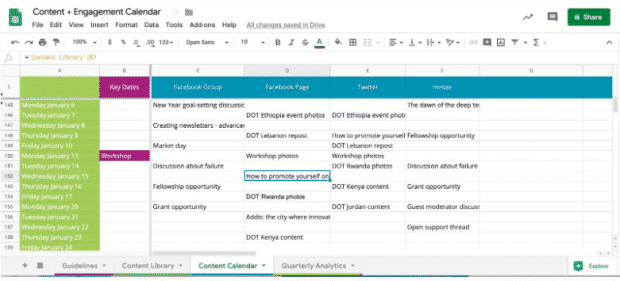 Source: DOT
Source: DOT
Meanwhile, DOT’s content library tab functions as a self-explanatory holding pen for inspiration, evergreen content, and as-yet-unscheduled future posts.
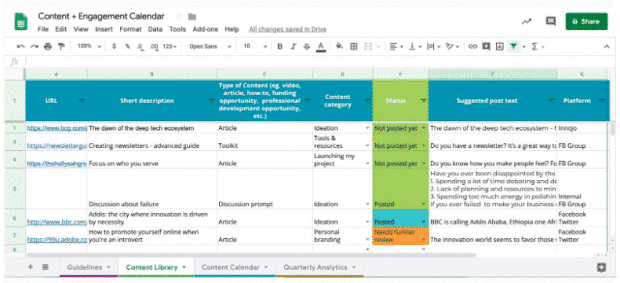 Source: DOT
Source: DOT
3. Hootsuite’s internal social media content calendar
Our third and final example is where we put our money where our mouth is. Check out what Hootsuite’s internal social media team gets up to in Google Sheets.
 Source: Hootsuite
Source: Hootsuite
Hootsuite’s social media team uses both Google Sheets and the Hootsuite Planner. This Sheets calendar (above) serves many channels with multiple posts per day.
Users scroll horizontally to see different platforms, and vertically to see future or past dates. And when posts go live, the text gets stricken out. (It’s very satisfying.)
Meanwhile, the “content pillar / topic” column is so important it has its own key in a separate tab:
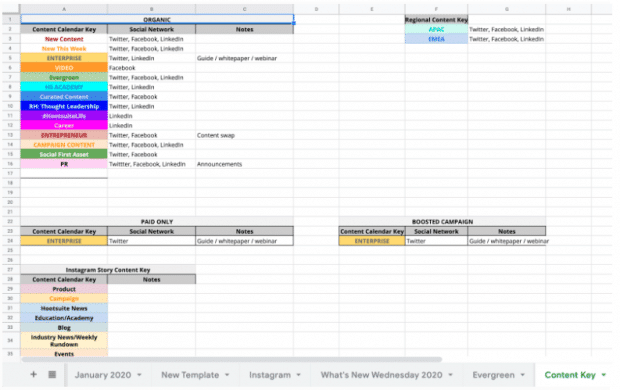 Source: Hootsuite
Source: Hootsuite
The team also keeps an “evergreen” tab, sorted by platform, to keep high-quality resources close at hand, no matter the season.
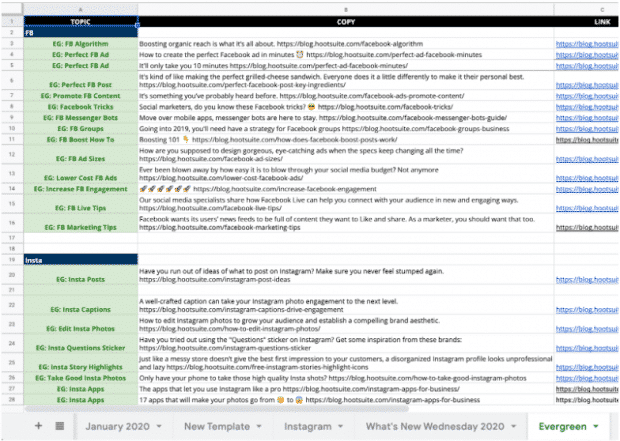 Source: Hootsuite
Source: Hootsuite
According to Social Media Manager Amanda Wood, due to the large volume of content Hootsuite publishes, Sheets is helpful to sketch out content across all channels, often far in advance. The team might enter placeholder posts (i.e., posts without finalized copy, links or assets) to get the lay of the land and ensure a healthy mix of topics.
The Hootsuite Planner, on the other hand, is where Hootsuite’s finalized social media posts get mapped out with their assets attached, in preparation for scheduling and posting.
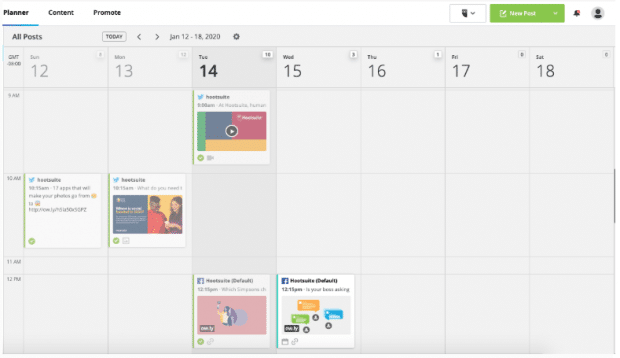 Source: Hootsuite
Source: Hootsuite
Free editorial and social media calendar templates
If you’re ready to get started, we have two Google Sheets templates for you to take a look at. Just open the link, make a copy, and plan away.
Social media editorial calendar template
This template is intended for planning individual content assets. Think blog posts, polished videos, new research, et cetera. In other words, this is where you plan out the content that your social media efforts will be promoting.
Create a new tab for each month, and plan your editorial content out week by week.
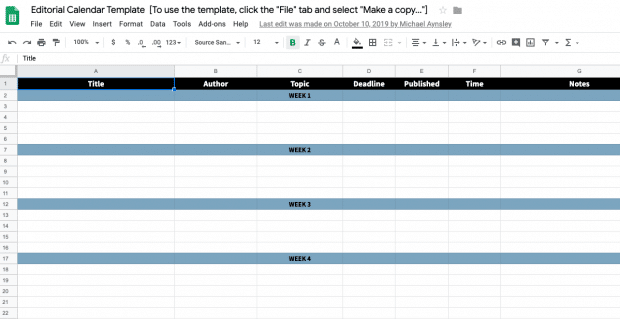
Click here to start using our editorial calendar template in Google Sheets.
Social media content calendar template
This calendar template makes space for the big four major platforms and focuses on a weekly scale. But it’s highly customizable, and you’re free to make it your own.

Like the editorial calendar above, just open the file and create your own copy. Make sure to create a new tab for each month, and plan out your editorial content week by week.
Bonus: Download our free, customizable social media calendar template to easily plan and schedule all your content in advance.
Among the many helpful items in this calendar, make sure not to miss the tab for evergreen content. This is a content repository for blog posts that always perform well on social, despite seasonality. It includes:
-
- Type of content
- Original publication date (keep track of this so you know when it’s time for an update)
- Title
- Topic
- URL
- Top performing social copy
- Top performing image
Social media content calendar apps and tools
Honestly there are probably as many different social media content calendar tools as there are social media managers. (Firefighter wall calendar? Microsoft Outlook? Do as you like!)
Google Sheets
Do we even have to list this one? Yes. Google Sheets is the microwave oven of your social media kitchen: you’re not going to brag about it to your foodie friends, but life without it would be unnecessarily complicated.
And while it may take some extra time to start rolling with pivot tables (or just make the thing look decent), our handy social media calendar templates at least take care of that second point.
Trello
For simple, free, friendly-looking social media calendar tools, it doesn’t get more obvious than Trello. We like this one because we already use it as our prettiest to-do list tool, and it’s easy to add relevant files, links and notes. (It also has a calendar view add-on.)
That said, what Trello offers in visuals it lacks in flexibility. If you have a team workflow that includes vetting and approvals; or you want to compile long-term analytics; or you just want to be able to see everything at once—you’ll want a more advanced tool.

Hootsuite Planner
Our favourite social media content calendar tool, of course (you knew this was coming), is the Hootsuite Planner.
It eclipses even our trusty Google Sheets because you can publish directly from the calendar.
You get your visual overview, all your assets (copy, visuals, links) in one place. All you have to do is hit post. (Or, even better: schedule.) Check out how it works in this video.
Once you’ve planned your content calendar, use Hootsuite Planner to schedule all of your social media posts, engage with your followers, and track the success of your efforts. Sign up today.
The post How to Create a Social Media Content Calendar: Tips and Templates appeared first on Hootsuite Social Media Management.
Categories
- 60% of the time… (1)
- A/B Testing (2)
- Ad placements (3)
- adops (4)
- adops vs sales (5)
- AdParlor 101 (43)
- adx (1)
- algorithm (1)
- Analysis (9)
- Apple (1)
- Audience (1)
- Augmented Reality (1)
- authenticity (1)
- Automation (1)
- Back to School (1)
- best practices (2)
- brand voice (1)
- branding (1)
- Build a Blog Community (12)
- Case Study (3)
- celebrate women (1)
- certification (1)
- Collections (1)
- Community (1)
- Conference News (1)
- conferences (1)
- content (1)
- content curation (1)
- content marketing (1)
- contests (1)
- Conversion Lift Test (1)
- Conversion testing (1)
- cost control (2)
- Creative (6)
- crisis (1)
- Curation (1)
- Custom Audience Targeting (4)
- Digital Advertising (2)
- Digital Marketing (6)
- DPA (1)
- Dynamic Ad Creative (1)
- dynamic product ads (1)
- E-Commerce (1)
- eCommerce (2)
- Ecosystem (1)
- email marketing (3)
- employee advocacy program (1)
- employee advocates (1)
- engineers (1)
- event marketing (1)
- event marketing strategy (1)
- events (1)
- Experiments (21)
- F8 (2)
- Facebook (64)
- Facebook Ad Split Testing (1)
- facebook ads (18)
- Facebook Ads How To (1)
- Facebook Advertising (30)
- Facebook Audience Network (1)
- Facebook Creative Platform Partners (1)
- facebook marketing (1)
- Facebook Marketing Partners (2)
- Facebook Optimizations (1)
- Facebook Posts (1)
- facebook stories (1)
- Facebook Updates (2)
- Facebook Video Ads (1)
- Facebook Watch (1)
- fbf (11)
- first impression takeover (5)
- fito (5)
- Fluent (1)
- Get Started With Wix Blog (1)
- Google (9)
- Google Ad Products (5)
- Google Analytics (1)
- Guest Post (1)
- Guides (32)
- Halloween (1)
- holiday marketing (1)
- Holiday Season Advertising (7)
- Holiday Shopping Season (4)
- Holiday Video Ads (1)
- holidays (4)
- Hootsuite How-To (3)
- Hootsuite Life (1)
- how to (5)
- How to get Instagram followers (1)
- How to get more Instagram followers (1)
- i don't understand a single thing he is or has been saying (1)
- if you need any proof that we're all just making it up (2)
- Incrementality (1)
- influencer marketing (1)
- Infographic (1)
- Instagram (39)
- Instagram Ads (11)
- Instagram advertising (8)
- Instagram best practices (1)
- Instagram followers (1)
- Instagram Partner (1)
- Instagram Stories (2)
- Instagram tips (1)
- Instagram Video Ads (2)
- invite (1)
- Landing Page (1)
- link shorteners (1)
- LinkedIn (22)
- LinkedIn Ads (2)
- LinkedIn Advertising (2)
- LinkedIn Stats (1)
- LinkedIn Targeting (5)
- Linkedin Usage (1)
- List (1)
- listening (2)
- Lists (3)
- Livestreaming (1)
- look no further than the new yorker store (2)
- lunch (1)
- Mac (1)
- macOS (1)
- Marketing to Millennials (2)
- mental health (1)
- metaverse (1)
- Mobile App Marketing (3)
- Monetizing Pinterest (2)
- Monetizing Social Media (2)
- Monthly Updates (10)
- Mothers Day (1)
- movies for social media managers (1)
- new releases (11)
- News (72)
- News & Events (13)
- no one knows what they're doing (2)
- OnlineShopping (2)
- or ari paparo (1)
- owly shortener (1)
- Paid Media (2)
- People-Based Marketing (3)
- performance marketing (5)
- Pinterest (34)
- Pinterest Ads (11)
- Pinterest Advertising (8)
- Pinterest how to (1)
- Pinterest Tag helper (5)
- Pinterest Targeting (6)
- platform health (1)
- Platform Updates (8)
- Press Release (2)
- product catalog (1)
- Productivity (10)
- Programmatic (3)
- quick work (1)
- Reddit (3)
- Reporting (1)
- Resources (34)
- ROI (1)
- rules (1)
- Seamless shopping (1)
- share of voice (1)
- Shoppable ads (4)
- Skills (28)
- SMB (1)
- SnapChat (28)
- SnapChat Ads (8)
- SnapChat Advertising (5)
- Social (169)
- social ads (1)
- Social Advertising (14)
- social customer service (1)
- Social Fresh Tips (1)
- Social Media (5)
- social media automation (1)
- social media content calendar (1)
- social media for events (1)
- social media management (2)
- Social Media Marketing (49)
- social media monitoring (1)
- Social Media News (4)
- social media statistics (1)
- social media tracking in google analytics (1)
- social media tutorial (2)
- Social Toolkit Podcast (1)
- Social Video (5)
- stories (1)
- Strategy (601)
- terms (1)
- Testing (2)
- there are times ive found myself talking to ari and even though none of the words he is using are new to me (1)
- they've done studies (1)
- this is also true of anytime i have to talk to developers (1)
- tiktok (8)
- tools (1)
- Topics & Trends (3)
- Trend (12)
- Twitter (15)
- Twitter Ads (5)
- Twitter Advertising (4)
- Uncategorised (9)
- Uncategorized (13)
- url shortener (1)
- url shorteners (1)
- vendor (2)
- video (10)
- Video Ads (7)
- Video Advertising (8)
- virtual conference (1)
- we're all just throwing mountains of shit at the wall and hoping the parts that stick don't smell too bad (2)
- web3 (1)
- where you can buy a baby onesie of a dog asking god for his testicles on it (2)
- yes i understand VAST and VPAID (1)
- yes that's the extent of the things i understand (1)
- YouTube (13)
- YouTube Ads (4)
- YouTube Advertising (9)
- YouTube Video Advertising (5)
